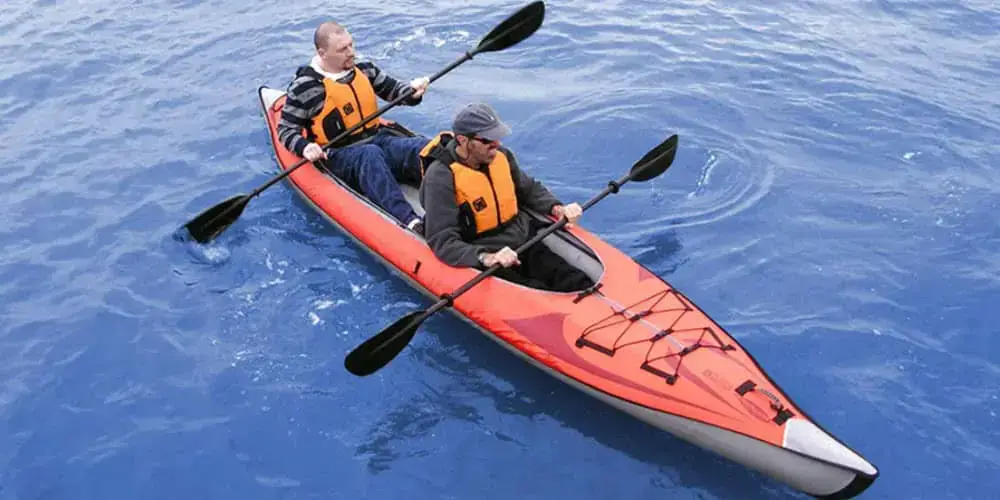
In this article, you will discover the numerous advantages of using inflatable kayaks. From their portability and ease of transportation to their durability and stability on the water, these kayaks offer a convenient and enjoyable paddling experience. You will also learn about their versatility in different types of water and how they are suitable for beginners and experienced kayakers alike. So, if you are curious about the benefits of inflatable kayaks, keep reading to find out more.
Introduction
Welcome to the world of inflatable kayaks! Whether you are a seasoned kayaker looking for a convenient and portable option or a beginner wanting to explore the waters, inflatable kayaks are an excellent choice. In this article, we will delve into the various benefits of using inflatable kayaks, their suitability for different environments, and compare them with traditional kayaks. We will also discuss the different types and models available in the market, important features to consider when buying one, and address common misconceptions. So, grab your paddle and get ready to explore the amazing world of inflatable kayaks!
What are inflatable kayaks?
Definition of inflatable kayaks
Inflatable kayaks are watercraft that can be inflated and deflated conveniently, allowing for easy transportation and storage. Unlike traditional kayaks, which are usually made of hard materials such as plastic or fiberglass, inflatable kayaks are constructed with durable, puncture-resistant materials such as PVC or Hypalon. These materials not only make the inflatable kayaks robust but also lightweight and flexible.
Materials used in inflatable kayaks
Inflatable kayaks are crafted using a variety of materials like PVC, Hypalon, and Nitrylon. PVC is the most commonly used material due to its durability, affordability, and resistance to UV rays. Hypalon, on the other hand, offers enhanced resistance to abrasions and chemicals, making it ideal for rougher waters. Nitrylon is a newer material that combines the benefits of both PVC and Hypalon by providing durability and puncture resistance along with increased environmental friendliness.

Benefits of using inflatable kayaks
Portability and ease of transportation
One of the major advantages of inflatable kayaks is their portability. Unlike traditional kayaks, which require racks or trailers for transportation, inflatable kayaks can be easily folded and carried in a compact bag. You can even fit them in the trunk of your car or check them in as luggage when traveling by air. This makes it incredibly convenient to explore new waters and take your kayak on adventures wherever you go.
Storage and space-saving
Inflatable kayaks shine when it comes to storage limitations. Traditional hard-shell kayaks take up a significant amount of space in your garage or shed, requiring dedicated storage racks or space. Inflatable kayaks, on the other hand, can be deflated and stored in a relatively small bag, allowing you to save valuable storage space. This makes them perfect for apartment dwellers or anyone with limited storage options.
Affordability and cost-effectiveness
Compared to traditional kayaks, inflatable kayaks are considerably more affordable. Inflatable kayaks are typically priced lower than their hard-shell counterparts, making them a cost-effective option for those on a budget. Additionally, the maintenance and repair costs for inflatable kayaks are generally lower. In the event of damage, patches or repair kits are often included, allowing you to easily fix minor issues yourself.
Versatility and adaptability
Inflatable kayaks are versatile and can be used in various water environments. Whether you prefer calm lakes, lazy rivers, rough rapids, or even coastal waters, there is an inflatable kayak suitable for your needs. Some models even offer adaptability by allowing you to attach skegs or rudders for improved tracking or convert them into tandem kayaks for a great bonding experience with a friend or family member.
Durability and resistance
While it may be tempting to assume that inflatable kayaks are not as durable as their hard-shell counterparts, modern inflatable kayaks are built to withstand rigorous use. The puncture-resistant materials used in their construction, along with reinforced seams and multiple air chambers, ensure excellent durability and resistance. This means you can confidently navigate through rocky waters or shallow areas without worrying about damaging your kayak.
Safety features and stability in water
Inflatable kayaks are designed to provide stability and safety in the water. Their wide and stable base, combined with the low center of gravity, makes them less prone to tipping over. Additionally, inflatable kayaks often come equipped with multiple air chambers, which provide added buoyancy in case one chamber is punctured. This feature ensures that even in the unlikely event of a puncture, you can safely paddle back to shore.
Suitability for different environments
Inflatable kayaks in calm lakes and rivers
If you enjoy peaceful paddling in calm lakes or serene rivers, inflatable kayaks are a perfect fit for you. They offer a stable and comfortable ride, allowing you to effortlessly explore and enjoy the beauty of your surroundings. Inflatable kayaks provide a relaxed and peaceful experience, making them great for leisurely trips or fishing excursions.
Inflatable kayaks in whitewater and rapids
Contrary to popular belief, inflatable kayaks are not limited to calm waters only. Many models are specifically designed to handle whitewater and rapids. With their sturdy construction and excellent maneuverability, inflatable kayaks can navigate through challenging water conditions with ease. Whether you are an experienced kayaker looking for an adrenaline-pumping adventure or a beginner wanting to try something new, whitewater inflatable kayaks are a thrilling option.
Inflatable kayaks in open sea and coastal waters
Inflatable kayaks are also well-suited for exploring open sea and coastal waters. While they may not provide the speed and performance of high-end sea kayaks, inflatable kayaks are a fantastic option for recreational sea kayaking. They offer stability, portability, and are perfect for exploring calm coves, bays, and coastal areas. Just make sure to choose an inflatable kayak with proper sea-worthy features, such as a skeg or rudder, for improved tracking and control.

Comparing inflatable kayaks with traditional kayaks
Weight and transportation
Traditional kayaks are typically heavy and require additional equipment such as roof racks or trailers for transportation. Inflatable kayaks, on the other hand, are lightweight and can be transported easily. You can carry them in a backpack or a small bag, making them extremely convenient for hiking to remote water bodies or traveling long distances.
Setup and assembly
Setting up an inflatable kayak is a straightforward process that usually takes just a few minutes. Most inflatable kayaks come with a pump that enables quick and easy inflation. Traditional kayaks, on the other hand, require more effort and time-consuming assembly. With inflatable kayaks, you can spend more time on the water and less time on preparation.
Performance and maneuverability
In terms of performance and maneuverability, traditional kayaks may have an edge over inflatable kayaks. Hard-shell kayaks usually have sleek designs and glide more smoothly through the water, offering better speed and control. However, inflatable kayaks have come a long way in terms of design and technology. Many models now feature improved hull designs and skegs or rudders that enhance performance and maneuverability, providing a comparable experience to traditional kayaks.
Comfort and seating
Both inflatable kayaks and traditional kayaks offer comfortable seating options. Inflatable kayaks often come with adjustable seats that allow you to find your desired level of comfort. Some models even have inflatable backrests for added support. Traditional kayaks may offer more padding or ergonomic features, but inflatable kayaks can still provide a comfortable experience for extended periods of paddling.
Maintenance and repair
Maintaining and repairing inflatable kayaks are generally easier and less costly compared to traditional kayaks. Inflatable kayaks require minimal maintenance, with simple cleaning and drying after each use sufficient to keep them in good condition. In case of damage, many inflatable kayaks come with repair kits or patching materials, allowing you to fix minor punctures easily. Traditional kayaks may require regular cleaning, waxing, and potential repairs for any cracks or damages.
Different types and models of inflatable kayaks
Recreational inflatable kayaks
Recreational inflatable kayaks are perfect for beginners and casual paddlers. They are typically designed for calm waters and offer a stable and comfortable ride. Recreational kayaks are easy to handle and maneuver, making them great for leisurely trips, fishing, or family outings. They often have spacious cockpits and ample storage space for your gear and supplies.
Touring inflatable kayaks
Touring inflatable kayaks are designed for longer expeditions and exploring vast stretches of water. They offer enhanced speed, tracking, and stability, making them suitable for longer paddling distances. Touring kayaks usually have more advanced features, such as skegs or rudders, to improve performance and control. These kayaks are ideal for intermediate to advanced paddlers who seek extended adventures.
Fishing inflatable kayaks
Inflatable fishing kayaks are specially designed for fishing enthusiasts. They offer stability, ample storage options for fishing gear, and often have mounting points for additional accessories like rod holders or fish finders. Fishing kayaks are typically wider and more stable than recreational or touring kayaks, allowing for a steady platform to cast your line from.
Inflatable kayaks for whitewater
For those seeking an adrenaline rush on whitewater rapids, whitewater inflatable kayaks are the go-to choice. These kayaks are built with reinforced materials, multiple air chambers, and special designs that enable them to withstand the demands of rough waters. Whitewater inflatable kayaks offer superior maneuverability and control, allowing you to navigate through challenging rapids with ease.

Important features to consider when buying an inflatable kayak
When considering purchasing an inflatable kayak, there are several important features to keep in mind:
Size and weight capacity
Ensure that the kayak you choose can comfortably accommodate your weight and any additional gear or supplies you plan to carry. Most inflatable kayaks have weight capacity limits clearly specified by the manufacturer.
Inflation and deflation mechanisms
Check the inflation and deflation mechanisms of the kayak. Look for kayaks with efficient and user-friendly valves and pumps that make the setup and takedown process quick and hassle-free.
Stability and tracking
Consider the stability and tracking features of the kayak. Look for models with wider hull designs, multiple air chambers, and optional skegs or rudders for improved stability and tracking performance.
Seating and comfort
Evaluate the seating options and comfort features of the kayak. Look for adjustable seats, inflatable backrests, or additional padding that can enhance your comfort during long hours of paddling.
Storage compartments and accessories
Assess the storage options available in the kayak. Look for models with spacious storage compartments or bungee cords for securing your gear and supplies. Additionally, consider any additional accessories or attachment points that may be valuable to your paddling needs.
Paddle and rudder options
Consider the paddle and rudder options available for the kayak. Some inflatable kayaks come with included paddles, while others require you to purchase them separately. Also, check if there are provisions for attaching a skeg or rudder to improve control and tracking.
Manufacturer’s warranty and customer support
Lastly, consider the manufacturer’s warranty and customer support offered. A reliable warranty will give you peace of mind in case of any manufacturing defects or issues. Additionally, responsive customer support can greatly assist you with any questions or concerns you may have regarding your kayak.
Common misconceptions about inflatable kayaks
Inflatable kayaks are easily punctured
One common misconception about inflatable kayaks is that they are fragile and prone to punctures. While it is true that inflatable kayaks can be punctured if not used and handled properly, modern inflatable kayaks are built with durable and puncture-resistant materials. With proper care and following manufacturer guidelines, punctures are rare, and if they occur, they can be easily repaired.
Inflatable kayaks have poor performance
Another misconception is that inflatable kayaks lack performance and cannot match the speed or maneuverability of traditional kayaks. While it is true that hard-shell kayaks may have certain advantages in terms of speed and glide, inflatable kayaks have come a long way and now offer improved hull designs, tracking features, and optional skegs or rudders that enhance their performance and maneuverability. Many inflatable kayaks can provide a comparable experience to traditional kayaks.
Inflatable kayaks are not suitable for experienced kayakers
Some experienced kayakers may believe that inflatable kayaks are only suitable for beginners or recreational paddlers. However, inflatable kayaks are designed for a wide range of paddling experiences. There are models specifically created for whitewater adventures or touring expeditions, offering advanced features and performance. Experienced kayakers can enjoy the convenience, portability, and versatility that inflatable kayaks offer without compromising their paddling experience.

Tips for inflating, deflating, and maintaining inflatable kayaks
Proper inflation techniques
When inflating your kayak, make sure to follow the manufacturer’s instructions. Start by inflating the floor first, gradually working your way up to the sides. Use a pump to avoid over-inflation and ensure that all chambers are evenly filled. Give the kayak a final inspection to ensure proper inflation before hitting the water.
Correct deflation and folding procedures
When deflating your kayak, remove any accessories or gear and open all air valves. Press down gently on the kayak to release any trapped air. Fold the kayak loosely in the opposite direction of the air valves, allowing air to escape. Begin rolling the kayak tightly from one end to the other, removing any remaining air. Once fully deflated, secure the kayak with straps or the provided bag.
Cleaning and storage recommendations
After each use, rinse your kayak with fresh water to remove any salt or debris. Use a mild soap if necessary, but avoid harsh chemicals that may damage the material. Dry the kayak thoroughly before storage to prevent mold or mildew. It is recommended to store the kayak in a cool, dry place away from direct sunlight to prolong its lifespan. Ensure the kayak is completely dry before folding and storing it in the provided bag.
Conclusion
Inflatable kayaks offer numerous benefits that make them a fantastic choice for both beginners and experienced kayakers alike. They provide portability, ease of transportation, and storage-saving solutions. Inflatable kayaks are affordable, versatile, and durable, making them suitable for various water environments. By considering your desired paddling experience, important features, and debunking common misconceptions, you can confidently explore the world of inflatable kayaks. So, grab a paddle, inflate your kayak, and embark on your next exciting water adventure!








